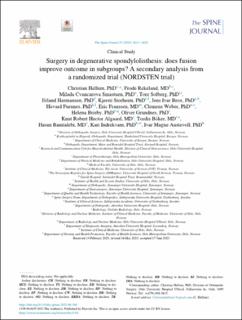Surgery in Degenerative Spondylolisthesis: Does fusion improve outcome in subgroups? A secondary analysis from a randomized trial (NORDSTEN trial)
Hellum, Christian; Rekeland, Frode Gurvin; Småstuen, Milada Cvancarova; Solberg, Tore; Hermansen, Erland; Storheim, Kjersti; Brox, Jens Ivar; Furunes, Håvard; Franssen, Eric; Weber, Clemens; Brisby, Helena; Grundnes, Oliver; Robert Hector Algaard, Knut; Bøker, Tordis; Banitalebi, Hasan; Indrekvam, Kari; Austevoll, Ivar Magne
Peer reviewed, Journal article
Published version
Permanent lenke
https://hdl.handle.net/11250/3097937Utgivelsesdato
2023Metadata
Vis full innførselSamlinger
Originalversjon
10.1016/j.spinee.2023.06.386Sammendrag
BACKGROUND CONTEXT: Patients with spinal stenosis and degenerative spondylolisthesis
are treated surgically with decompression alone or decompression with fusion. However, there is
debate regarding which subgroups of patients may benefit from additional fusion.
PURPOSE: To investigate possible treatment effect modifiers and prognostic variables among
patients operated for spinal stenosis and degenerative spondylolisthesis.
DESIGN: A secondary exploratory study using data from the Norwegian Degenerative Spondylo-
listhesis and Spinal Stenosis (NORDSTEN-DS) trial. Patients were randomized to decompression
alone or decompression with instrumented fusion.
PATIENT SAMPLE: The sample in this study consists of 267 patients from a randomized multi-
center trial involving 16 hospitals in Norway. Patients were enrolled from February 12, 2014, to
December 18, 2017. The study did not include patients with degenerative scoliosis, severe forami-
nal stenosis, multilevel spondylolisthesis, or previous surgery.
OUTCOME MEASURES: The primary outcome was an improvement of ≥ 30% on the Oswestry
Disability Index score (ODI) from baseline to 2-year follow-up.
METHODS: When investigating possible variables that could modify the treatment effect, we ana-
lyzed the treatment arms separately. When testing for prognostic factors we analyzed the whole
cohort (both treatment groups). We used univariate and multiple regression analyses. The selection
of variables was done a priori, according to the published trial protocol.
RESULTS: Of the 267 patients included in the trial (183 female [67%]; mean [SD] age, 66 [7.6]
years), complete baseline data for the variables required for the present analysis were available for
205 of the 267 individuals. We did not find any clinical or radiological variables at baseline that
modified the treatment effect. Thus, none of the commonly used criteria for selecting patients for
fusion surgery influenced the chosen primary outcome in the two treatment arms. For the whole
cohort, less comorbidity (American Society of Anesthesiologists Classification [ASA], OR = 4.35;
95% confidence interval (CI [1.16−16.67]) and more preoperative leg pain (OR = 1.23; CI [1.02
−1.50]) were significantly associated with an improved primary outcome.
CONCLUSIONS: In this study on patients with degenerative spondylolisthesis, neither previously
defined instability criteria nor other pre-specified baseline variables were associated with better
clinical outcome if fusion surgery was performed. None of the analyzed variables can be applied to
guide the decision for fusion surgery in patients with degenerative spondylolisthesis. For both treat-
ment groups, less comorbidity and more leg pain were associated with improved outcome 2 years
after surgery.

